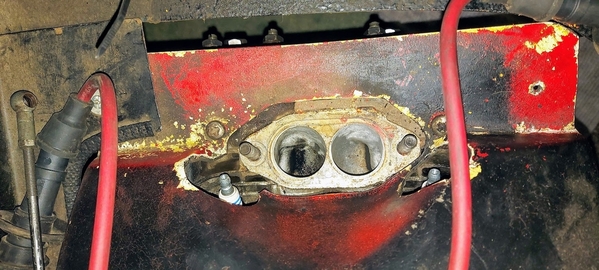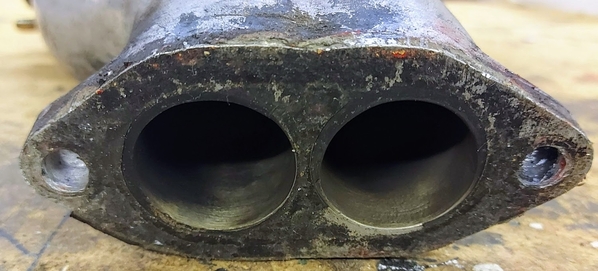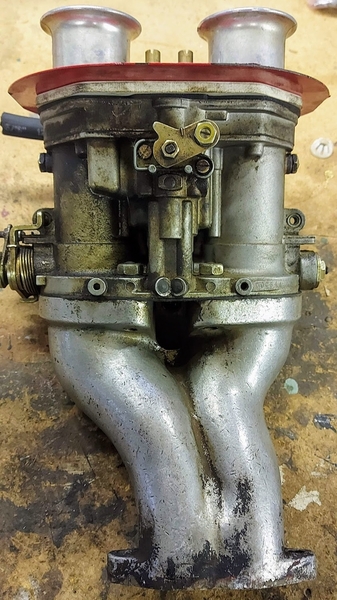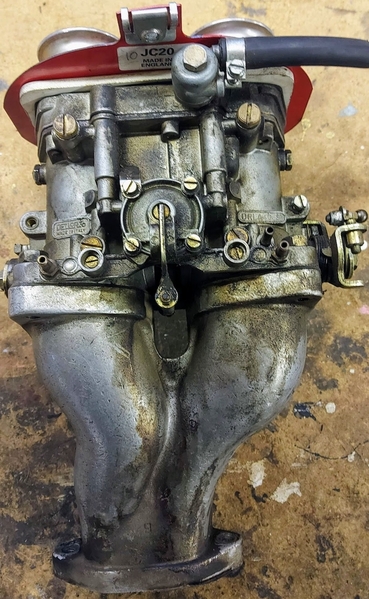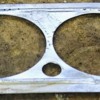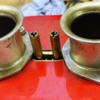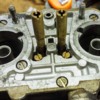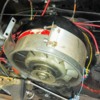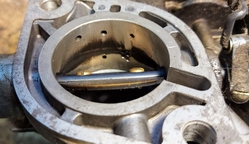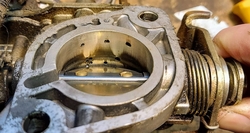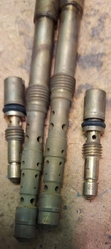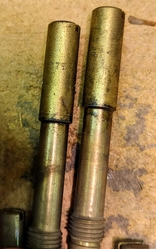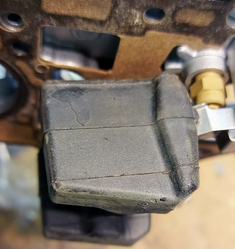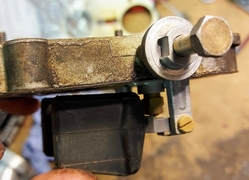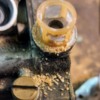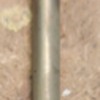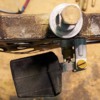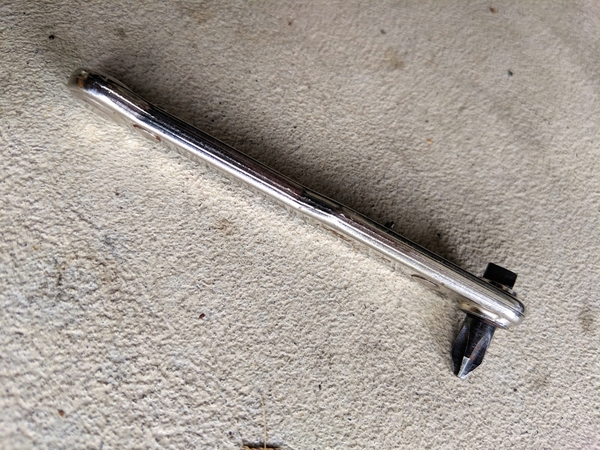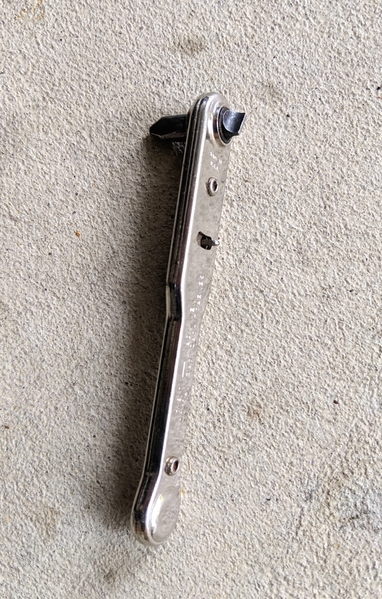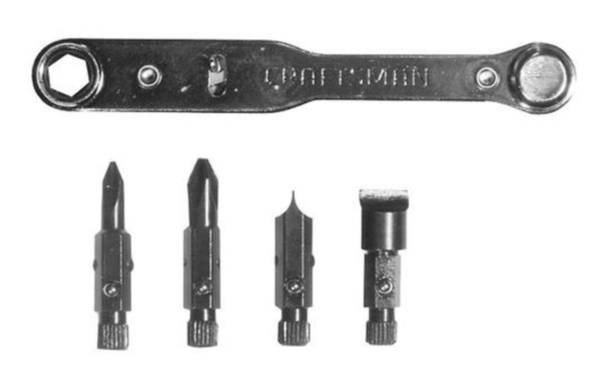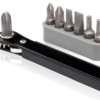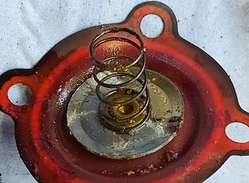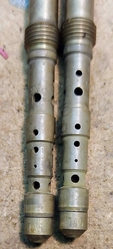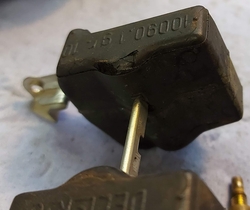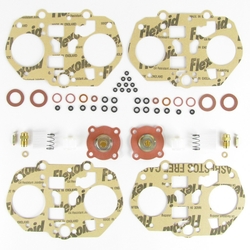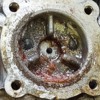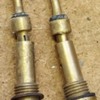Everything comes off skin with the right chemicals LOL! Skin too.
Permatex, POR -15 and GM black windshield cement are all with you until you have generated new skin.
Any particular grease @Stan Galat @DannyP @LI-Rick? Moly (CV) grease, Lithium, General Purpose?
Grease for what purpose? Different slick'ems for different things. ![]()
For the valve cover gaskets, just about anything: Regular automotive general purpose or molybdenum grease (my favorite, cause it gets all over everything amnd makes my wife think I'm doing something useful out there), white lithium grease, that green or purple stuff that the auto parts stores sell, whatever. All you're trying to do is get the gasket moistened such that it'll kinda-sorta stick to the cover while installing, and swell very slightly once installed, when the engine heat thins the grease out to flow and let the gasket try to expand and seal.
Be careful when installing the cover/gasket, as they always seem to bulge out somewhere as they try to escape while you're focused on getting the cover aligned. Oftan you can't see the bulge/gap and tighten things down only to later find a massive oil leak caused by the gap. No gap-osis allowed.
Thanks Gordon. You correctly guessed I was talking about the valve cover gasket seal. I was wondering whether one wanted the grease to melt slightly or not, given the heat. I’ll order some cork gaskets tomorrow once I’ve figured out what I also need to order for the leaking flange seal (above). Always worth combining orders to reduce overall postage costs.
The valve covers need to come off at least 1x/yr to adjust the valves. I like the cork gaskets, and until now I've used CSP valve covers. I reuse gaskets at least once or twice. I've not needed any adhesive, but then again there are retaining clips to keep the gasket from sucking in on the valve covers I've been using.
I also wipe the sealing surfaces with a dab 'o grease (which only serves to keep the gaskets from sticking to the head the next time I remove the covers). The kind of grease is pretty much irrelevant, since it isn't really doing very much besides being a bit sticky when you are assembling things (which is a good thing). but I've never been able to stop the valve covers from weeping. I guess I'd rather have that than a 2 hour job scraping adhesive off the covers and the heads (and then still having them leak).
With the new engine, I'm running stock German valve covers and bales for the first time. We'll see how it goes.
Your mileage may vary.
Stock valves covers and bales ( in good condition) seems to be the best to avoid leaks. While everyone has their own method to seal, I use a very thin layer of silicone gasket maker only on the valve cover side of the gasket from the L & R top corners , down the sides and across the bottom only wiping any excess away. I've never had VC leaks since doing this way.
Ok, bulk pack of 10 neoprene/cork rocker cover gaskets ordered (£6.75, around $9.24 for comparison), 2 final drive flange seals (£6 each - figured I might as well do both rather than just one), and some new exhaust gaskets for when I refit the exhaust.
I tried to buy a new fanbelt (ok, alternator belt) because I don't know the age of the existing one, but I'm struggling to find the correct-sized replacement. I've not yet dismantled the 911-style shroud to see how the alternator is mounted, but I measured the old belt and it was 860mm (about 33.8") OD and 10mm wide. None of the belts available in aircooled stores come close to this length - at minimum they are 900mm. Any suggestions, please?
Now I've got my Dellorto Super Performance handbook, I've started to dig out the carbs from the engine bay and begine the careful process of cleaning them. For now I'm working on the right carb only and even to my uninitiated eyes it's filthy dirty!
 First off, pull the plug leads then thank goodness for small hands as I squeeze them into the gap to get a 12mm spanner on the manifold bolts. You'll see here the fibreglass shroud cut away to allow access, but it's been a bit bodged to make everything fit.
First off, pull the plug leads then thank goodness for small hands as I squeeze them into the gap to get a 12mm spanner on the manifold bolts. You'll see here the fibreglass shroud cut away to allow access, but it's been a bit bodged to make everything fit.
I know a lot of you will say ditch the shroud and go back to standard cooling, but this is a learning car for me and I don't want to spend unnecessarily. I'll go with what I have for now and if I get another I'll go the stock route.
Anyway, you can see that, as well as loads of crud on the manifold (bad seal, obvs) there's red paint(!), which means the manifold has been bolted down onto a corner of the shroud, so no wonder the car was popping and banging.I'll have to get the dremel out on the shroud once I remove it.
The PO was charged a a few hundred quid by his preferred aircooled 'specialist' to clean the carbs before he sold me the car and I bet all they did was take off the air filters and stick an air hose down the intakes. No noticeable cleaning took place (nor did they clean out/replace the fuel filters). If you want something doing properly, do it yourself, eh? To be fair, £200 would barely cover the time needed to strip down one carb, let alone 2 and the rest of the fuel system.
The gasket is pretty mangled as well so that wil be replaced.
So, here they are in all their mucky glory:
The distributor uses a vacuum advance from the right carb. Also the No1 cylinder mixture control screw was wound out 4.75 turns compared to No2's 3 turns. I'll check the left carb but that might explain why the exhaust pics on a previous post are sooty for 1 and 3 and clear for 2 and 4?
Anyway, time to start stripping the carb down and cleaning everything up. I have my trusty air hose and an ultrasonic cleaner large enough to take one whole body, and some Simple Green (which is tricky to find in UK, but reasonable price). I'll document everything on here (as a carb novice) in case it's useful - if I search for 'DRLA' on this site all I find are old adverts for owners selling them!
One thing I will say - the way these carbs are mounted means it's almost impossible to adjust when in place. The adjustment screws are all facing outwards and there's precious little space in a Chesil engine bay.
Attachments
So, a few more pics of the first carb disassembly.
First off, I open up the fuel intake filter and all this falls out!! Yikes
Then the butterflies showing some soot on the barrels, even when closed:
Jets (including more dirt):
Left to right, idle jets are 58s, mains are 175s, starter emulsion tube 80 (with free debris!).
Floats look very old and worn.
The fully open position looks about right but the 'full' shut-off position looks a bit high, so will check and adjust this later.
Attachments
A question for carb afficionados, if I may. If my main jets are 175, but I've no idea if they're right for the car or not (because it's not run right in my short ownership before taking it off the road to check ovef and refurb the car) , which service kit should I buy from Dellorto - the one with 150 main jets or the one with 170 main jets?
I know that's like asking 'how long is this piece of string I'm holding behind my back' but it's worth a shot! I presume in the absence of options, I'd go with the nearest (170) and see how it goes. Any advice appreciated. If none, I can always ask Dellort to perhaps swap out the jets in the service kit with 175s. Given how poorly the car has run due to so much dirt and crud in the system, I've no idea how well this car can run. Just cleaning the entire system through should make a significant difference.
Thanks, Martin
Martin, main jets and idle jets are not normally changed during a rebuild. All gaskets, O-rings, float valves, and accelerator pump diaphragms are the usual parts in a rebuild kit.
The only real way to know if your jetting is correct is to read the plugs(which is difficult for the main jets) or to use a wideband O2 sensor to read them real-time.
About 2.5 turns out is a good point for Dellorto idle screws. When the car is running well, if the screws are less than 2 turns out is an indication of too large an idle jet. Conversely if the screws are over 3 turns out, running well, the jets are probably too small.
It is easiest to mount the manifolds and carbs with the engine out, but you gotta do what you gotta do. Definitely grind down that offending red fiberglass, just enough to clear the manifold. Make sure you seal the air leaks in the shroud wherever you find them. I have a 911 shroud in my Spyder. The belt should be available at any auto parts store that is not aircooled-specific. I get mine at a local NAPA store. I'm hoping you have a similar type of store in your country.
You may need to make/modify a screwdriver to make it short enough to get to the screws. It's tight working outboard of the carbs in ALL Speedsters. Some are worse(CMC and Vintage), some are better(Beck).
Martin: I futzed around with my Dellorto 40's for Years before I finally threw in the towel and sent them to a professional at Blackline Racing here in the states.
When they went out to them, this is what I had installed for jetting:
These carburetors come stock with:
60 idle jets
140 Main jets,
180 air correction jets,
35 accelerator pump jets and
34mm venturiis.
I had drilled the Mains out to 162.5 (happens to be a drill size) to overcome transition hesitation, which never went away.
This is what they had when I got them back from the rebuild, set up to my engine specs by Dave Hogland at Blackline Racing in Utah, who set them up on a flow bench and then tested them on a 1915cc engine (mine is a 2,110).
The jet sizes are:
.45 idles
1.30 mains
160 air correctors (to slow down the fuel through the main jets to overcome hesitation)
.35 Accelerator pump jets
32mm Venturis
E-Tube = #2
They are now so smooth they feel like fuel injection. I love 'em.
Martin, a few years ago I found this handy tool at a local Ace Hardware. Double-sided with Phillips head one side and standard on other side and reversible ratchet action. End-to-end it's 4.5 inches long. Perfect for turning those carb adjustment screws in tight spaces. If I had an extra one I'd send to to you. ![]()
Attachments
.
@Martin's Eleven (UK) and @MusbJim , this little gizmo was available for years from Sears in the US (# 41469) , but seems hard to find today (and probably harder in the UK),
But, it's just a small 1/4 inch ratchet with some bits, so seems like this would do the same from the UK Amazon site:
And oh (sometime later), here's the link at Ace in the US for the one Jim posted.
.
Attachments
here is on flea.. here or here on the Can Sitecan amazon A very small 1/4 drive socket could be made to hold a bit... just saying
@Martin's Eleven (UK) posted:A question for carb afficionados, if I may. If my main jets are 175, but I've no idea if they're right for the car or not (because it's not run right in my short ownership before taking it off the road to check ovef and refurb the car) , which service kit should I buy from Dellorto - the one with 150 main jets or the one with 170 main jets?
I know that's like asking 'how long is this piece of string I'm holding behind my back' but it's worth a shot! I presume in the absence of options, I'd go with the nearest (170) and see how it goes. Any advice appreciated. If none, I can always ask Dellort to perhaps swap out the jets in the service kit with 175s. Given how poorly the car has run due to so much dirt and crud in the system, I've no idea how well this car can run. Just cleaning the entire system through should make a significant difference.
Thanks, Martin
Are the carbs just dirty on the outside? If your carbs aren't leaking (gas or air) then you don't necessarily need to tear apart and rebuild. What I suggest is observing how it runs on the idle circuits, buying idle jets and tuning appropriately before playing with mains. This is because if (after getting the mains right) you start changing idle jets (gas or air), the mains will now not be right. You need to get the idle circuit right first! I believe Danny has a good write up on carb tuning and I've always liked Aircooled.net's https://www.aircooled.net/vw-carburetors-jetting-102/
The owner (John Connolly) has actually recommended driving Webers/Dellortos with the mainstacks pulled out in some situations for guys to understand how much you drive on the idle circuits and how important it is to get it right first.
Hope this helps. Al
Gentlemen, many thanks for all your answers. Much appreciated as always. Given the state the current fuelling is in, there are so many things I need to do just to get back to a good basic setup (service the carbs, new gaskets, widening the gap in the 911-style shroud to remove any chance of air leaks etc), that I'll do all of that before I start on differing jet sizes etc.
I've disassembled the carb fully and cleaned it today - OMG!
I presume this gelatinous gunk is old fuel sitting and 'reducing' like a good jus..One of the problems of more ethanol in our fuel?
I'll be sending off for a full gasket/O-ring service kit but the question about jet sizes above was because Dellorto UK offer the same service kit with two differing (new) jet sizes. In looking more closely today whilst cleaning everything, I find my Dellorto DRLA 40 actually has chokes/venturis sized 34. And the main jets which had 175 stamped on the long top part of the screw actually had 145 jets inserted in the bottom:
So it all looks a little more reasonable. I'm learning on the job, here, so it's all fun. At least the dirt and gunk everywhere explains why the car would only run roughly on idle jets and as soon as I hit 3k revs the car would misfire and lose power like fuel starvation. I'm looking forward to getting this all
However, there will be an extra expense of new floats - one is split so I might as well replace both (they're around £46/$63 each over here).
The service kit is £122/$161 for dual carbs:
Total cost (including manifold gaskets) - £219/$300. Not cheap, but this should see the carbs sorted for the next decade. I'm guessing nothing has been changed on this for 20 years.
On another topic, the rocker cover gaskets and flange seals arrived today so I'll fit them tomorrow.
Attachments
@Martin's Eleven (UK) posted:Gentlemen, many thanks for all your answers. Much appreciated as always. Given the state the current fuelling is in, there are so many things I need to do just to get back to a good basic setup (service the carbs, new gaskets, widening the gap in the 911-style shroud to remove any chance of air leaks etc), that I'll do all of that before I start on differing jet sizes etc.
I've disassembled the carb fully and cleaned it today - OMG!
I presume this gelatinous gunk is old fuel sitting and 'reducing' like a good jus..One of the problems of more ethanol in our fuel?
I'll be sending off for a full gasket/O-ring service kit but the question about jet sizes above was because Dellorto UK offer the same service kit with two differing (new) jet sizes. In looking more closely today whilst cleaning everything, I find my Dellorto DRLA 40 actually has chokes/venturis sized 34. And the main jets which had 175 stamped on the long top part of the screw actually had 145 jets inserted in the bottom:
So it all looks a little more reasonable. I'm learning on the job, here, so it's all fun. At least the dirt and gunk everywhere explains why the car would only run roughly on idle jets and as soon as I hit 3k revs the car would misfire and lose power like fuel starvation. I'm looking forward to getting this all
However, there will be an extra expense of new floats - one is split so I might as well replace both (they're around £46/$63 each over here).
The service kit is £122/$161 for dual carbs:
Total cost (including manifold gaskets) - £219/$300. Not cheap, but this should see the carbs sorted for the next decade. I'm guessing nothing has been changed on this for 20 years.
On another topic, the rocker cover gaskets and flange seals arrived today so I'll fit them tomorrow.
Definitely a dirty gunky mess and it's a good thing you're cleaning it all. One, it'll run way better once cleaned and two, you get your hands dirty and will know the carbs inside and out which leads to a better understanding of how they work. When/if there's every another issue you'll be able to diagnose it faster.


